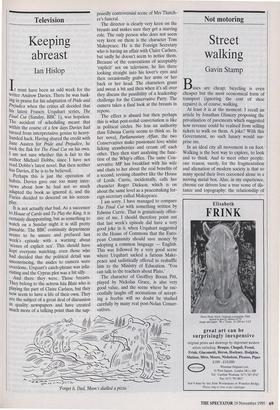Not motoring
Street walking
Gavin Stamp
Buses are cheap; bicycling is even cheaper but the most economical form of transport (ignoring the cost of shoe repairs) is, of course, walking.
At least it is at the moment: I recall an article by Jonathan Glancey proposing the privatisation of pavements which suggested how revenue could be realised from selling tickets to walk on them. A joke? With this Government, no such lunacy would sur- prise me.
In an ideal city all movement is on foot. Walking is the best way to explore, to look and to think. And to meet other people: one reason, surely, for the fragmentation and alienation of modern society is that so many spend their lives cocooned alone in a moving metal box. Also, in my experience, chronic car drivers lose a true sense of dis- tance and topography: the relationship of places is only understood in terms of a car journey and not in actual distance and ori- entation. Only walkers can know places intimately. And walking is the best form of exercise. Cars — and, it must be said, pub- lic transport — have made us lazy. Car- driving societies are fat societies — look at the United States.
Almost everybody once walked. Until the late 19th century, with the introduction of suburban railways and, more important, of the trams, most journeys in London were made on foot. Ordinary people made daily journeys inconceivable to today's lazy com- muters. Charles Dickens was constantly walking all over London and out to Hamp- stead — sometimes he walked to Rochester overnight, And what was con- ventional can be grasped from his novels: Bob Cratchitt, for instance, walked daily from Camden Town to the City and back. There was no other way; horse-drawn buses were expensive and slow and only plied a few routes. Until the London Coun- ty Council introduced cheap electric trams, the only way to commute from, say, Wal- worth or Camberwell was on foot.
So the pedestrian ought to reign supreme in a city. But, of course, in the car-dominated 20th century he (or she) does not; the pedes- trian is merely tolerated — if at all. For, a European, one of the horrors of America is the way in which walking is impossible in certain cities, in which all journeys are made on four wheels and it is assumed that anyone walking is mad or criminal.
But even in Britain so many urban plans have been drawn out, so many new roads have been built on the false assumption that everyone will have a car and nobody will walk. Victorian railways were arrogant enough, but usually they penetrated cities on viaducts or in cuttings. Railways seldom form impassable barriers within cities, but main roads often do as fast-moving streams of traffic have captured the level ground. So, when planners are compelled, grudging- ly, to recognise the existence of the anachronistic pedestrian, he (or she) is con- fined like cattle behind fences and obliged to cross either underground or up steps.
But why should those who walk be forced to descend into sordid, claustrophobic and often threatening pedestrian underpasses? To use such things is an unpleasant as well as an unnecessary urban experience. Fortu- nately, human nature fights back. Fences, walls and those areas of rough stones like miniature tank traps which thoughtful road engineers place alongside urban motorways will not deter the true and agile citizen who — as I do — believes that the pedestrian has a God-given right to stay on the level in towns and cities.
One of the great crimes committed in Glasgow in the 1960s was to drive the M8 through the middle, so dividing the West End from the city centre. Those who did this blocked pre-existing streets and only provided a few pedestrian overbridges in inconvenient places. A photograph in Images of Glasgow, a new book of pho- tographs published in the Herald, reveals what happened: one showing Charing Cross in 1974 is captioned, 'In the early days there was an outcry about lack of pedestrian crossings and this picture was especially taken to show how Glaswegians responded by vaulting the railings and walking along the roadway regardless of the danger of fast-moving traffic.' Good for them: this photograph records a tri- umph of the human spirit.
It is cars which should be forced under- ground, not humans. In truly civilised cities, that is now happening.



















































































 Previous page
Previous page